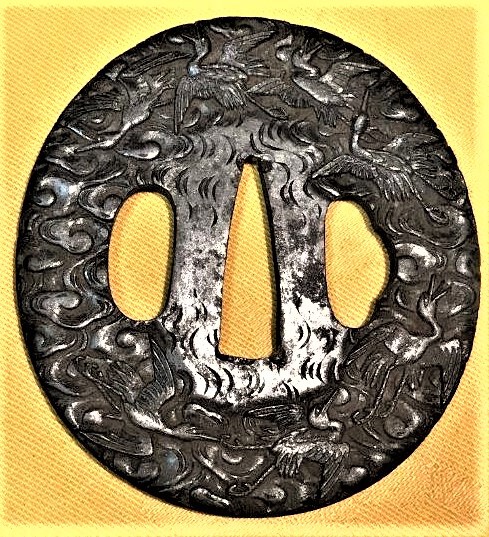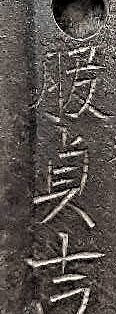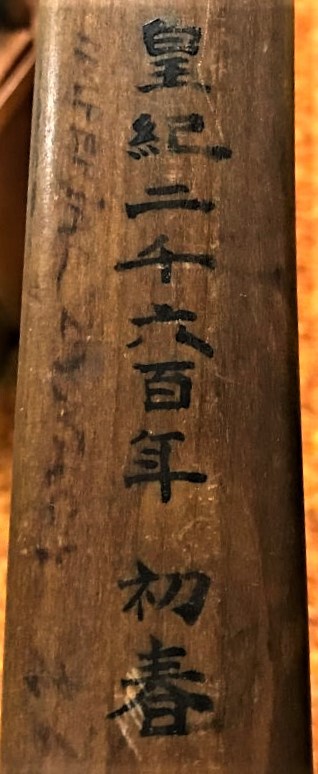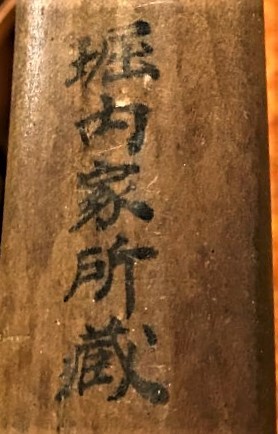-
Posts
703 -
Joined
-
Last visited
-
Days Won
4
Everything posted by Ron STL
-
I have had several kogatana polished over the years and they can be quite enjoyable to see. As Brian pointed on, only the one side is polished, not the signature side.. While many kogatana mei can be ignore, you do find those that were forged and tempered. If the signature appears well made is well cut (as on your kogatana) I would feel pretty good that it was hand forged. The sugata of your kogatana also seems well made. Truly as signed? Hmmm...here you need to go at least the kogatana book (I forget the official title) to see how close the mei comes to the book example. Lucky for me, I have a local friend who does an excellent job on kogatana, so it does not cost much to bring out their beauty. A miniature shirasaya would be nice too, but I haven't ventured into those. John Yumoto used to say if you wanted a big name kogatana your went into a shop and picked out what you wanted. Nothing was hand made in those shops, but the lack of craftsmanship can be easily spotted. A well made kogatana should show its quality craftsmanship (just like a sword would do). Ron STL
-
Thanks for the excellent examples. They are definitely convincing. Appreciate the direction as where to go on this. Interesting that the cranes are almost identical except more of these cranes have their bills open whereas your example they are closed, more relaxed. This on must be by Mitsumasa or being unsigned, from his stable, I would say. I found the blossom tsuba in Murtha's book but he did not identify a school. Would say again a Bushu group associated with Mitsumasa. Again, my thanks for this excellent help. Now I must read more about this group. Ron STL
-
I've just acquired this interesting iron tsuba which is covered in flying cranes, etc., that are carried over the rim onto the back of the tsuba. I'm puzzled where to place this tsuba (group), so your thoughts are appreciated. The tsuba is slightly oval, measuring 72 mm x 6.7 mm x 5mm. Notice some of the carving carry over onto the seppa dai. Looking forward to your thoughts on this. Ron STL
-

Help identifying inherited sword
Ron STL replied to MillstoneBoroVintage's topic in Translation Assistance
So nice to see a nicely preserved (not abused, chipped and rusted) turn up like this. As to what steps to take with the sword, is this something you would preserve and appreciate (being inherited) or is of only passing interest. Often, a non-collector would rather turn a sword into $$$ and hopefully put it into the hands of an appreciative collector. There are many sincere and honest collectors around. Taking it to San Francisco to the NTHK shinsa would authenticate the signature (or not pass it as "as signed"). If your only interest in selling the sword, shop around the show and get a feel for what it is worth and sell it. If nothing else, it would be a great learning experience for you. If you have any family history on the sword, it's always nice to pass that on to the next owner. Ron STL -
That is so very interesting. I suppose it telling up that SADAYOSH is an old established family, and obviously a patron of Naokatsu in his early days. Thank you very much Moriyama san for identifying this for me. Ron STL
-
I have been studying a shinshinto wakizashi with includes the "special ordered by" inscription. The 2nd kanji (right below the ana) needs explaining to accurately understand the inscription. I've asked a knowledgeable friend, but how this is read (before the patron's name) remained not clearly understood. Perhaps a NMB member who is fluent in Japanese can help? Let's see what happens. Appreciate clearing this reading up, if only for my records. Ron STL
-
Decision on this sword is to submit to shinsa at the San Francisco show and if it passes, the polisher with complete restoration. If failed, it will be returned to me. Probably a safe move to take. Ron
-
The close-up shows nicely formed what is probably ko-nie and the line of sunagashi seems to indicate a masame forging along the cutting edge, which is a promising thing to look for in an koto sword. Always important to see if the nie (or ko-nie) is made clear and consistant, not blotchy and oversized here and there. Ron
-
I've been studying a sword I've judged as shodai Tadatsuna, convinced by the mei and what I could see of the hamon. It's now with the polisher, but he commented that the hamon was difference than what he had seen for Tadatsuna. I found it interesting that only the Shinto Taikan and Nihonto Zuikan Shintohen show any examples of the father, shodai. I've found a few papered examples through Google. So I'll ask, if anybody can post authenticated examples of shodai Tadatsuna where the hamon is shown, please direct me to them for study. I may be wise to await NBTHK shinsa whenever that is possible, before spending on polish. I usually trust myself, but... Attached, a composite showing (roughly) what is on my sword. Ron STL 310 Hamon as-is.docx
-
Interesting to see to see this sword and its jigane, hamon. About two months ago I posted a mumei sword with a very similar forging and hamon. Initially, it was called a fake, Chinese, etc., but soon settled down once realizing it was a real sword. Discussion ended with it being called koto or shinshinto. I have considered sending it to Japan for shinsa once virus restrictions settle down. Now I wonder if it might be this same Yoshihiro??? or at least his group. Wonder if this sword was sold; seemed very fair priced if one liked the sword. Ron STL
-
That's a possibility Barry. Makes me recall such a wakizashi years ago that was "dressed" as an islander sword, but the blade was an interesting wakizashi, no doubt picked up in the field and redressed to taste. You may recall the blade, too, pictured in Fujishiiro Shintohen p. 309 if memory is correct. Nakajima polished the sword later but a large opening in the kissaki caused me to part with it. Back to the topic sword, I think the koshirae is too well made to have been redressed by some islander. Ron STL
-
Initially, I saw the butt of a matchlock but thought that strange. Oddly enough, I also thought of an African weapon which is totally strange, but I collected those for awhile. I would stick with Japanese culture here, but there is a good chance it related only to something important to the owner of the sword. Just look at the similar but different shapes of the tanto koshirae posted. If these things could only talk... Ron STL
-
Many years ago the late John Yumoto started to translate Zufu issues beginning with No. 1. He managed to get through maybe six years worth of Zufu and then he stopped. I have those translations and Zufu issues but loaned them out thinking it would be a nice on-going source of material for the JSS/US. Never happened and do need to get those translations back for safe keeping. When newsletter editor, I received a letter from Dr. Homma giving permission to use the material for the JSS. To ever translate all Zufu years would seem a daunting task, although much of the text/description follows a common format. I've had my Juyo swords translated by Marcus. Ron STL
-
Certainly looks like a horse's hoof but I bet it would represent something else. Let's see if anybody else has any idea on this. Ron STL
-
Here is a very strange and unique wakizashi saya that I'm trying to understand. Does anyone know what this shape is representing. I've been unable to locate such a saya in my koshirae books. Thanks Ron STL
-

Yoshindo Yoshihara sayagaki translation
Ron STL replied to Ron STL's topic in Translation Assistance
Thank you Morita san, I didn't think that read so straight forward, the handwriting was too difficult for me to read this. Now I have this pasted into the sword's record sheet. As always, your readings are very much appreciated. Ron STL -
Attached, a sayagaki written by Yoshindo Yoshihara for a Kuniie daito, that was gifted as a wedding present. I see the date and of course "Kuniie katana" but would love to know the full reading of the sayagaki. The script is beyond my ability to read. Thanks Ron STL
-
Thanks Steve, exactly what I was looking for. As for as the dating, I messed up on that. It is dated: "early spring" Koki 2600 (1940). Ron STL
-
-
Here are two sections of a sayagaki I'd like translated. It is thought that this was a gifted sword from so-and-so from so-and-so. The sayagaki is dated "early spring 2006" (Emperor dating system, 1939 I think. The sayagaki goes on to say :Izumi no kami Kanesada." I'm very curious if family names are given here which seems more likely than the names of individuals. Interesting sayagaki, I think. Help to complete this reading please. Ron STL
-
Thanks guys, for explaining this as you did. I know Tanobe san does use some unusual kanji in his sayagaki, more in recent years than earlier. His sayagaki can be works of calligraphy art, especially when they become lengthy. Since posting this I did locate the earlier breakdown of the sayagaki (no real detail though) and I see the word "masterpiece" was used by the translator. Also, back in 1979 (surprised to see it that long ago!) the NTHK held a shinsa during that year's big event. The Naokatsu was later mentioned in their journal reviewing the event. Another friend translated that brief text for me and again the word "masterpiece" was used. (attached wording), so maybe that might be a good one to use. The Naokatsu was given 83 pts. at that time, but I never followed through on sending it to Japan for their Yushu level certificate. I still need to check out Darcy's site and do some comparison. I hope to keep this breakdown as a file to help with the next sayagaki puzzle that comes along. As I said, it's a good learning tool. Ron STL
-
Attached photos show a sayagaki written by Tanobe san for my Yamon Naokatsu tachi, purchased back in the very early 1970s here in St. Louis. While checking the file on this beautiful sword, I realized I've never fully translated the sayagaki. Someone broke it down for me years ago but I'd very much like a more detailed (kanji by kanji) breakdown of the body of the sayagaki. Tanobe san wrote more than usual when signing it, so that would be wonderful to understand. If this is not asking too much here, I think this information would also benefit some of the newer members, too. The photos are in the order of the sayagaki. I understand the mei part and the Nagasa part. My main interest is in the body of the sayagaki and Tanobe's signing as I said. For those who might have the old 1979 Meibutsu Catalog from that year's exhibit, this Naokatsu is on the cover and listed inside. As always, my thanks for your help. Ron STL
-
Thanks for your impressions of this strange yari. It is truly a forged yari with a narrow hamon still visable and likely (based on the long kiri kubi), sue koto. The nakago is made like a yari's nakago, but these drillings would had definitely weakened it, I would think. These drillings appear to had been done a long time ago and are not something added using a drill press as mentioned. I agree it resembles a fantasy yari and the creation of somebody's imagination. Not a pretty thing for sure, just a curiosity. This is why I posted it, to see if it just might have some honest background in Japan. I wonder what that "odd sword posted" was about. Must have missed reading that post. Ron STL
-
Here is an 18" 3-sided yari with rather strange piercings along with the hori on it. One of our local guys brought this over for discussion a couple days ago. The yari is unsigned but could be sue-koto. None of us have ever seen this done to a yari before and while extreme and a bit strange, it has meaning to the owner who had this done to it. It would be interesting to see if anybody out there has seen something similar or would have an answer to what this symbolism truly represents. Ron STL
-
Thanks, exactly what I was looking for. This time I've filed this logically, where I can find it again when needed. Thanks! RonSTL









.thumb.png.50a491ecdc75482db987f7b4e1414c36.png)












